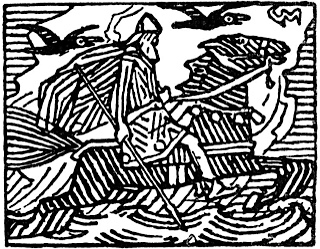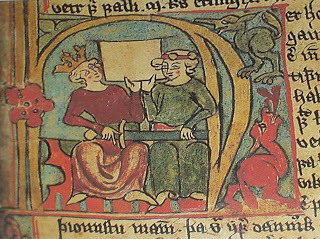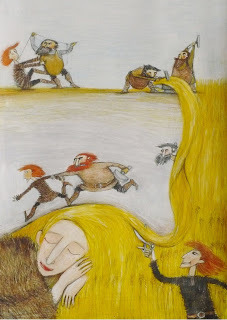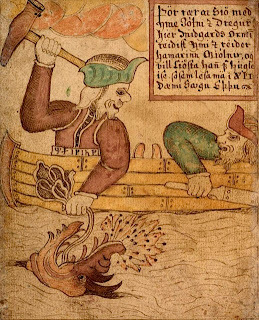Seven Norse Myths We Wouldn’t Have Without Snorri: Part IV
 Imagine you are a 40-year-old poet who wants to impress a 14-year-old king. You want to get him excited about Viking poetry—which happens to be your specialty—and land yourself the job of King’s Skald, or court poet. A cross between chief counselor and court jester, King’s Skald was a well-paid and highly honored post in medieval Norway. For over 400 years, the king of Norway had had a King’s Skald. Usually the skald was an Icelander—everyone knew Icelanders made the best poets.
Imagine you are a 40-year-old poet who wants to impress a 14-year-old king. You want to get him excited about Viking poetry—which happens to be your specialty—and land yourself the job of King’s Skald, or court poet. A cross between chief counselor and court jester, King’s Skald was a well-paid and highly honored post in medieval Norway. For over 400 years, the king of Norway had had a King’s Skald. Usually the skald was an Icelander—everyone knew Icelanders made the best poets.Except, it seems, 14-year-old King Hakon. He thought Viking poetry was old-fashioned and too hard to understand.
To change young Hakon’s mind, Snorri Sturluson began writing his Edda, the book that is our main, and sometimes our only, source for much of what we think of as Norse mythology.
Snorri started off, in about 1220, by writing an elaborate poem in praise of King Hakon and his regent, Earl Skuli. It was 102 stanzas long, in 100 different styles. No poet had ever written such a complicated skaldic poem. With it, Snorri was handing the young king his resume: There was no better candidate for King’s Skald.
It’s a really dull poem.
If you’re not in love with skaldic poems—if you don’t like riddles and trivia quizzes—it’s no fun to read.
 Snorri realized this. He did not send his poem to the young king. Instead, he began a new section of the Edda, explaining how skaldic poems worked.
Snorri realized this. He did not send his poem to the young king. Instead, he began a new section of the Edda, explaining how skaldic poems worked.One thing he had to explain were “kennings,” the riddles Viking poets loved. No poet writing in Old Norse before about 1300 would say “mead” when he or she could say “waves of honey,” or “ship” instead of “otter of the ocean,” or “sword” instead of “fire of the spear clash.”
And those are easy kennings to figure out. The harder ones refer to Norse myths.
For example, what did a Viking poet mean by saying “Aegir’s fire,” or “Freya’s tears,” or “Sif’s hair”?
The Norse gods Aegir and Freya and Sif hadn’t been worshipped for over 200 years in Norway or Iceland. Few people remembered the old stories of gods and dwarfs and giants, and so the old poems hardly made sense. For this reason, Snorri included in his Edda many stories about the gods: stories he had heard, stories he pieced together from old poems—and stories he simply made up.
Many of his stories feature Loki the Trickster. One of the most important for our understanding of the Norse gods is the time that Loki, out of mischief, cut off the goddess Sif’s long, golden hair.
 Her husband, the mighty Thor, was not amused. “He caught Loki and was going to break every one of his bones until he swore that he would get black-elves to make Sif a head of hair out of gold that would grow like any other hair.”
Her husband, the mighty Thor, was not amused. “He caught Loki and was going to break every one of his bones until he swore that he would get black-elves to make Sif a head of hair out of gold that would grow like any other hair.” Loki went to the land of the dwarfs. (Here, Snorri says dwarfs and black-elves are the same. Elsewhere he says they are different. It’s a problem in the Edda that bothered Tolkien greatly.)
Shortly, Loki and one of the dwarf smiths returned to Asgard with Sif’s new head of hair. They also brought five other treasures. Turns out, the dwarfs were happy to make Sif’s hair. They liked to show off their skills.
They made Freyr’s magic ship Skidbladnir, “which had a fair wind as soon as its sail was hoisted” and “could be folded up like a cloth and put in one’s pocket.”
And they made Odin’s spear, Gungnir, which “never stopped in its thrust.”
But greedy Loki wanted more treasures. So he wagered his head that the two dwarf smiths, Brokk and Eitri, could not make three more treasures as good as these three were.
The dwarfs took the bet.
Eitri put a pig skin in his forge. He told Brokk to work the bellows without stop. A fly landed on Brokk’s arm and bit him—but he ignored it. After a long while, Eitri took out of the forge a boar with bristles of gold. It could run across sea and sky faster than a horse, and its bristles blazed with light like the sun. This magic boar, Gullinbursti, became the god Freyr’s steed.
Next Eitri put a bar of gold in his forge. Again he told Brokk to work the bellows without stop. That pesky fly came back and bit Brokk on the neck—but Brokk ignored it. Out of the magic forge came Odin’s gold ring, Draupnir. Every ninth night it dripped eight rings just like itself.
Then Eitri put iron in the forge. He told Brokk to work the bellows, “and said it would turn out no good if there were any pause in the blowing.” The fly—which, of course, was Loki in fly form—landed this time on Brokk’s eyelid. It bit so hard the blood trickled into the dwarf’s eyes. Brokk swept a hand across his face— “You’ve almost ruined it!” his brother yelled. This treasure was Thor’s hammer, Mjollnir. It would strike any target and never miss. If thrown, it would return to Thor’s hand like a boomerang. It was so small, Thor could hide it in a pocket. But it had one fault: The handle was a little too short.
 When Brokk brought all six dwarf-made treasures to Asgard, the gods agreed Loki had lost the bet. The boar, the gold ring, and the hammer were every bit as good as Sif’s hair, Freyr’s ship, and Odin’s spear.
When Brokk brought all six dwarf-made treasures to Asgard, the gods agreed Loki had lost the bet. The boar, the gold ring, and the hammer were every bit as good as Sif’s hair, Freyr’s ship, and Odin’s spear.Thor grabbed hold of Loki and held him still so the dwarf could cut off his head. But Loki was a bit of a lawyer. Presaging Shakespeare’s Shylock by several hundred years, he told Brokk “that the head was his but not the neck.”
Loki didn’t get away scatheless. Since “the head was his,” Brokk decided to make an improvement to it: He stitched Loki’s lips together.
And if that story didn’t hold 14-year-old King Hakon’s attention, Snorri could make up others just as good. No other source tells of the dwarf smiths Brokk and Eitri or how the gods’ treasures came to be. Nor did there need to be a story about why gold is called “Sif’s hair.” Sif was blonde, after all.
In my next post in this series, I’ll look at one of Snorri’s funniest creations, the tale of Thor and Loki’s visit to the giant Utgard-Loki.
This essay was adapted from my biography of Snorri Sturluson, Song of the Vikings: Snorri and the Making of Norse Myths, published by Palgrave Macmillan. It originally appeared on the science fiction and fantasy lovers website Tor.com.
The illustration of Sif’s hair is by the Czech artist Hellanim, who has a wonderful series of drawings on Norse myths at http://hellanim.deviantart.com/gallery/
Join me again next Wednesday at nancymariebrown.blogspot.com for another writing adventure in Iceland or the medieval world.
Published on January 09, 2013 06:51
No comments have been added yet.



